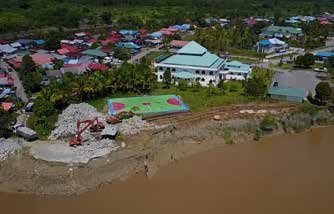The Batang Sadong River Corridor Rehabilitation Plan (RMKS) in Samarahan Division was an effort by the Malaysian Government, through the Department of Irrigation and Drainage (DID) Sarawak, to address severe riverbank erosion along the river that had affected the people living there.
It was one of several RMKS projects in Sarawak implemented under the 11th Malaysia Plan; the others being Batang Kayan, Lundu in Kuching Division, Batang Balingian and Batang Oya in Mukah Division, and the river at Rumah Naing, Nanga Muman-Teguyu, Ulu Spak in Betong Division.

With an overall project cost of RM23 million, the rehabilitation plan project at Batang Sadong was undertaken between 2016 and 2018 and was divided in two sections: the riverbank at Simunjan town (around RM15 million) and the other at Gedong town (around RM8 million).
The scope of the project encompassed steel sheet piling work, geotextile installation on the cliffs, armour rock layer installation with minimum thickness of 1.4 metres on the base of the riverbank, toe protection at the riverbed, earth filling works and drainage system construction.

The project also included the construction of a pedestrian walkway to provide a recreational area for the locals.
With the completion of the project, the negative impact of riverbank erosion on properties, safety and livelihood of those living in Simunjan and Gedong would be reduced for the long haul, preventing both towns from sinking into the river.
It had also led to more projects aiming to enhance the landscape along the riverbank.
Such is the case for Simunjan, which as of 2019, was undergoing landscape beautification along its main road, construction of additional rest-houses to cater to more visitors to the town and a waterfront development as part of efforts to transform the town into a tourist destination.
Doing so could open up more economic opportunities and diversification for locals who intend to generate more income and improve their standard of living, as well as encourage youths to contribute to development of their hometown development instead of migrating to bigger cities.







